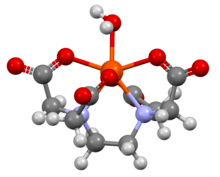Ferric EDTA
 | |
| Names | |
|---|---|
| Other names
(ethylenedinitrilo)tetraacetatoferrate | |
| Identifiers | |
3D model (JSmol) |
|
| ChemSpider | |
| EC Number | 241-171-3 |
PubChem CID |
|
| |
| |
| Properties | |
| C10H12FeN2O8 | |
| Molar mass | 344.06 g·mol−1 |
| Appearance | colorless |
| Hazards | |
| GHS pictograms |  |
| GHS signal word | Warning |
| H315, H319 | |
| P264, P280, P302+352, P305+351+338, P321, P332+313, P337+313, P362 | |
Except where otherwise noted, data are given for materials in their standard state (at 25 °C [77 °F], 100 kPa). | |
| Infobox references | |
Ferric EDTA is the coordination complex formed from ferric ions and EDTA. In contact with aerated natural waters, iron mainly exists in the ferric form. EDTA is a common chelating agent with a high affinity for ferric ions.[1] Near neutral pH, the principle complex is [Fe(EDTA)(H2O)]−, although most sources ignore the aquo ligand. The [Fe(EDTA)(H2O)]− anion has been crystallized with many cations, e.g., the trihydrate Na[Fe(EDTA)(H2O)].2H2O.[2] The salts are yellow-brown.
Uses
Together with pentetic acid (DTPA), EDTA is widely used for sequestering metal ions that otherwise decompose hydrogen peroxide, which is used to bleach pulp in paper making. Several million kilograms are produced for this purpose annually.[3]
Iron chelate is commonly used for agricultural purposes to treat chlorosis, a condition in which leaves produce insufficient chlorophyll. In horticulture, iron chelate is often referred to as 'sequestered iron' and is used as a plant tonic, often mixed with other nutrients and plant foods (e.g. seaweed). It is recommended in ornamental horticulture for feeding ericaceous plants like Rhododendrons if they are growing in calcareous soils. The sequestered iron is available to the ericaceous plants, without adjusting the soil's pH, and thus lime-induced chlorosis is prevented.
Iron chelate has also been used as a bait in the chemical control of slugs, snails and slaters in agriculture in Australia and New Zealand. They have advantages over other more generally poisonous substances used as their toxicity is more specific to molluscs.[4]
Ferric EDTA is also used to control some broadleaf weeds in lawns.
Related derivatives
Aside from ferric edta, iron complex of EDDHA is used to make the iron soluble in water and, for the purposes of agriculture, accessible to plants.
In iron chelation therapy, deferoxamine, has been used to treat excess iron stores, i.e. haemochromatosis.[5]
References
- ↑ Xue, Hanbin; Sigg, Laura; Kari, Franz Guenter (1995). "Speciation of EDTA in Natural Waters: Exchange Kinetics of Fe-EDTA in River Water". Environmental Science and Technology. 29: 59–68. doi:10.1021/es00001a007.
- ↑ Solans, X.; Font Altaba, M.; Garcia-Oricain, J. (1984). "Crystal Structures of Ethylenediaminetetraacetato Metal Complexes. V. Structures Containing the [Fe(C10H12N2O8)(H2O)]− Anion". Acta Crystallographica Section C. 40: 635–638. doi:10.1107/S0108270184005151.
- ↑ J. Roger Hart "Ethylenediaminetetraacetic Acid and Related Chelating Agents" in Ullmann's Encyclopedia of Industrial Chemistry, Wiley-VCH, Weinheim, 2005.doi:10.1002/14356007.a10_095
- ↑ Young CL, Armstrong GD (2001). "Slugs, Snails and Iron based Baits: An Increasing Problem and a Low Toxic Specific Action Solution". Australian Society of Agronomy. The Regional Institute. Retrieved 2009-10-18.
- ↑ "Hemochromatosis: Monitoring and Treatment". National Center on Birth Defects and Developmental Disabilities (NCBDDD). 2007-11-01. Archived from the original on May 18, 2009. Retrieved 2009-10-18.